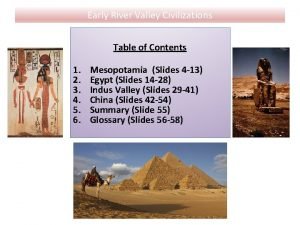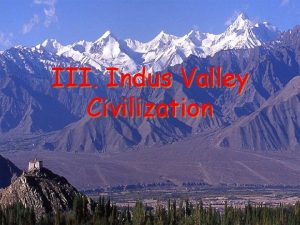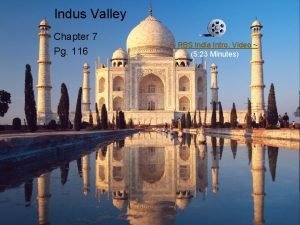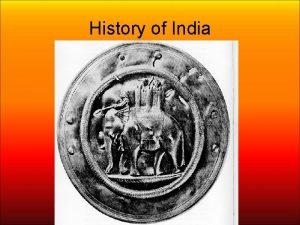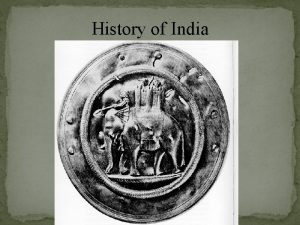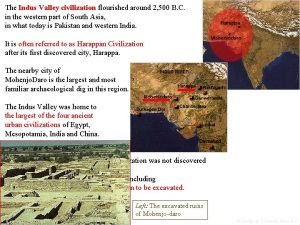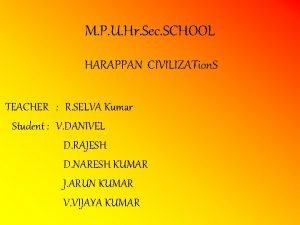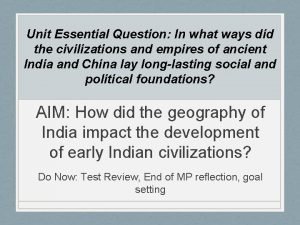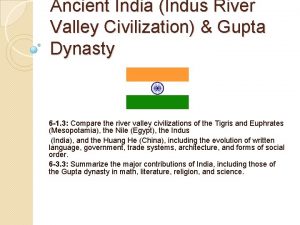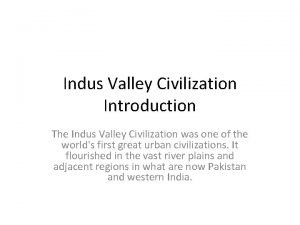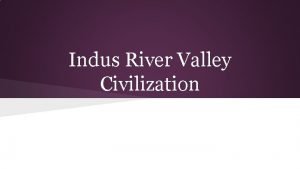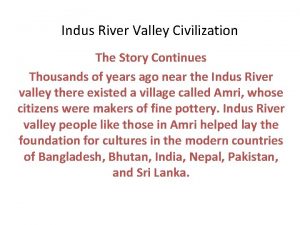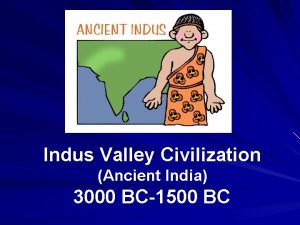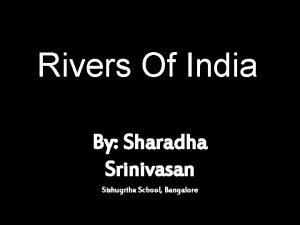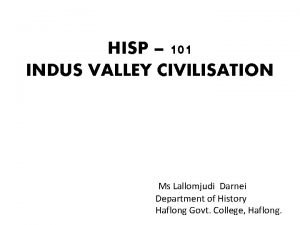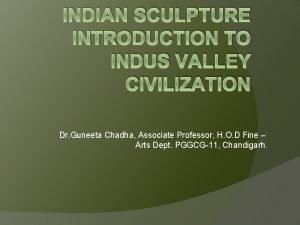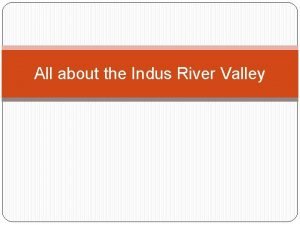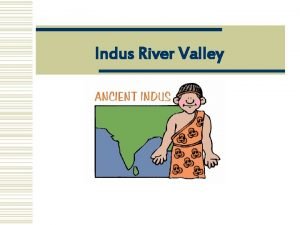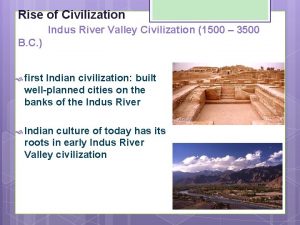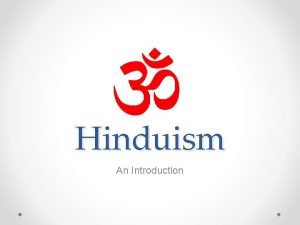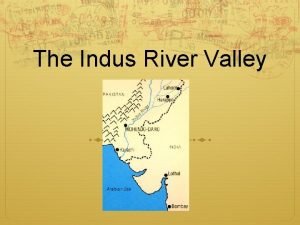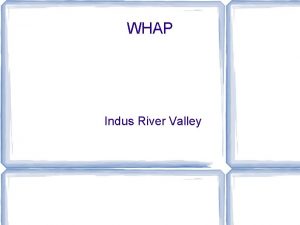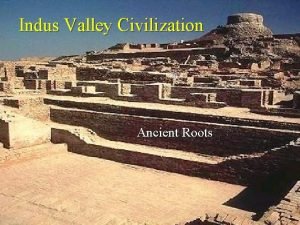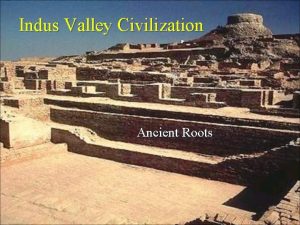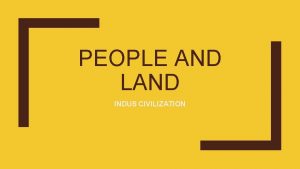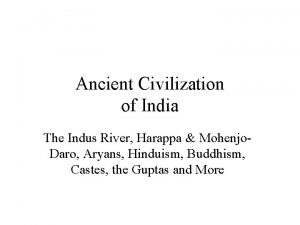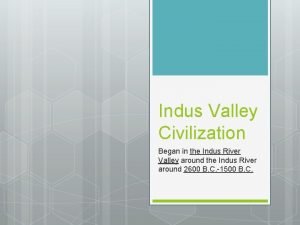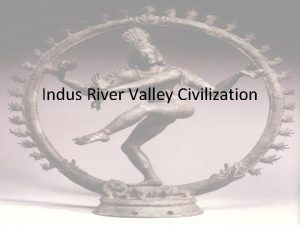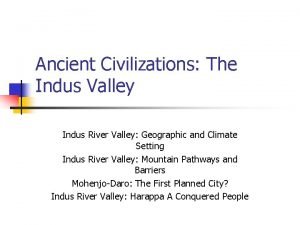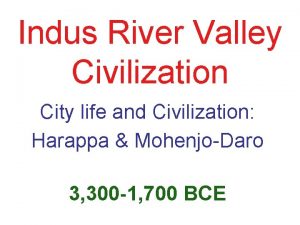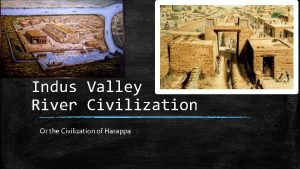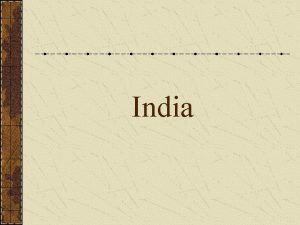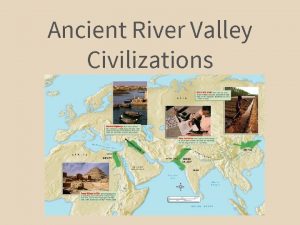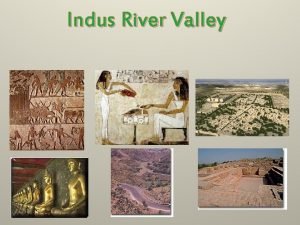ANCIENT INDIA The Indus River Civilization The Indus


























- Slides: 26

ANCIENT INDIA The Indus River Civilization

The Indus River Valley Civilization

The First Civilization on the Indus

The First people of the Indus Valley The Harrapans people created a city right on the banks of the Ind River around 5000 BCE. This City was unique because it was planned before it was built a had a plan for garbage disposal. Slums developed as the rich separated from the poor sections of Mohenjo Daro--- Sewers carried waste away from town

Mohenjo Daro as it appears today

Harrappa The ruins as they appear today The ruins are evidence of a well planned city The city was abandoned around 1500 BCE probably due to Aryan invasion

Artifacts tell the story Examine these artifacts. What was their purpose?

Artifacts of daily life Usage?

Aryan Invasion Around 1500 BCE, the Harrapans were invaded by a group of nomads from Siberia. The Harrapans had existed in isolation and peace for many years. Now they had to contend with invasion. Cultural Diffusion occurred as the Aryans introduce Sanskrit writing, iron technology, and the Caste System.

The Invasion Route

The Caste System Social Class dictated the way of life for thousands of Indian people. Brahmin Kshatriya

Vaishya Sudra

Dravidian --Untouchables

Hinduism Begins to develop This faith involves polytheism, reincarnation, concept of heaven, sacred animals, social class distinction Hinduism contains over 1, 000 gods and demigods Hindu Epics= long stories which include histories of India’s ancient dynasties. These texts serve as a cultural and mythological base for Indian society. a. Mahabharata= explains the gods and history of India’s dynasties --Bhagavad Gita = a substory in the Mahabharata served as inspiration to Mahatma Gandhi

Epics of Hinduism B. Ramayana---a story of devotion and duty Hero Rama rescues his wife Sita from dark lord Ravana, king of demons. Sugriva, king of the monkeys offered his help.

The Principles Reincarnation= your soul is reborn after death Karma= a force generated by your actions which will determine where and how you will be reborn in the next life Dharma= rules the Karma. Laws requiring people to do their duties associated with their caste Guru= a teacher Raja= King Maharaja= Prince

Sanskrit Writing

Buddhism Siddhartha Gautama a philisophical / religious movement based upon the teachings of real life Siddartha Gautama. 1. Life is full of suffering 2. Suffering is caused be selfish desires 3. End Suffering by

The Middle Path 4. Follow the Middle Path!!! These equal the 4 NOBLE TRUTHS WHAT ARE THE STEPS TO THE MIDDLE PATH? A. right mind b. Right intention C. right speech d. right action E. right livelihood f. right effort G. right mindfulness h. right concentration

The Result is Nirvana! Ultimate Reality!====Reunion with the Great World Soul! The selfish side of us is dead now. Reincarnation ends

The difference between Hinduism and Buddhism Buddha grew up as a Hindu Siddhartha accepted reincarnation but rejected the caste system, appealed to the down hearted, rejected the many gods and goddesses of Hinduism, forbade his followers from worshipping him. Siddhartha died in 480 bce at age 80 in modern day Nepal. His followers spread his teachings across Asia

Buddhist Architecture The Stupa Formed after Buddha’s Folded robe with his begging bowl on top

Buddhist Texts Tripitaka (Pali Canon) Mahayana Sutras Mahayana Buddhism reveres the Tripitaka as a sacred text, but adds to it the Sutras, which reflect distinctively Mahayana concepts. Most of the Mahayana Sutras, which number over two thousand, were written between 200 BCE and 200 CE, the period in which Mahayana Buddhism developed. Different divisions of Mahayana Buddhism emphasize different Sutras, but some texts, like the Lotus Sutra and Heart Sutra, are important to most branches of Mahayana. Tibetan Book of the Dead

Versions of Buddhism Today Much to choose from! Mahayana Vajrayana Theravada Buddhism Tibetan Buddhism Chán Tiantai Pure Land Zen Nichiren

Indian Dynasties Mauryan Founded by Chandra Gupta Maurya (324 BCE -301 BCE) Spread Law and Order Divided the land into Provinces Contacted the Mauryan under Asoka Converted to Buddhism Created Hospitals Created Veterianary Clinics for animals Rest areas for travelers

Indian Dynasties Kushan Empire Conquered Northern India Ran the Silk Road between the Roman Empire and China Traded spices with Europe and Asia Gupta Empire Trade with China Cloth, salt, iron New temples for Hinduism and Buddhism (375 -415 CE)
 Mesopotamia technology
Mesopotamia technology Ancient india vs ancient china
Ancient india vs ancient china Indus valley road
Indus valley road Indus economy
Indus economy Indus valley civilization period
Indus valley civilization period Natural resources of indus valley civilization
Natural resources of indus valley civilization Egyptian god of healing
Egyptian god of healing Economy of indus valley civilization
Economy of indus valley civilization Indus valley civilization trade and economy
Indus valley civilization trade and economy Search image
Search image The indus valley flourished from to bc
The indus valley flourished from to bc Education of indus valley civilization
Education of indus valley civilization Harappa map
Harappa map Caste system in indus valley civilization
Caste system in indus valley civilization Introduction to indus valley civilization
Introduction to indus valley civilization Introduction about harappan civilization
Introduction about harappan civilization Indus valley civilization recreation
Indus valley civilization recreation Aryan civilization
Aryan civilization Conclusion of indus valley civilization
Conclusion of indus valley civilization Conclusion of harappan civilization
Conclusion of harappan civilization Introduction about indus valley civilization
Introduction about indus valley civilization Indus river valley gender roles
Indus river valley gender roles Indus and ganges river
Indus and ganges river River valley civilizations
River valley civilizations Description
Description Indus and ganges river
Indus and ganges river Indus and ganges river
Indus and ganges river
